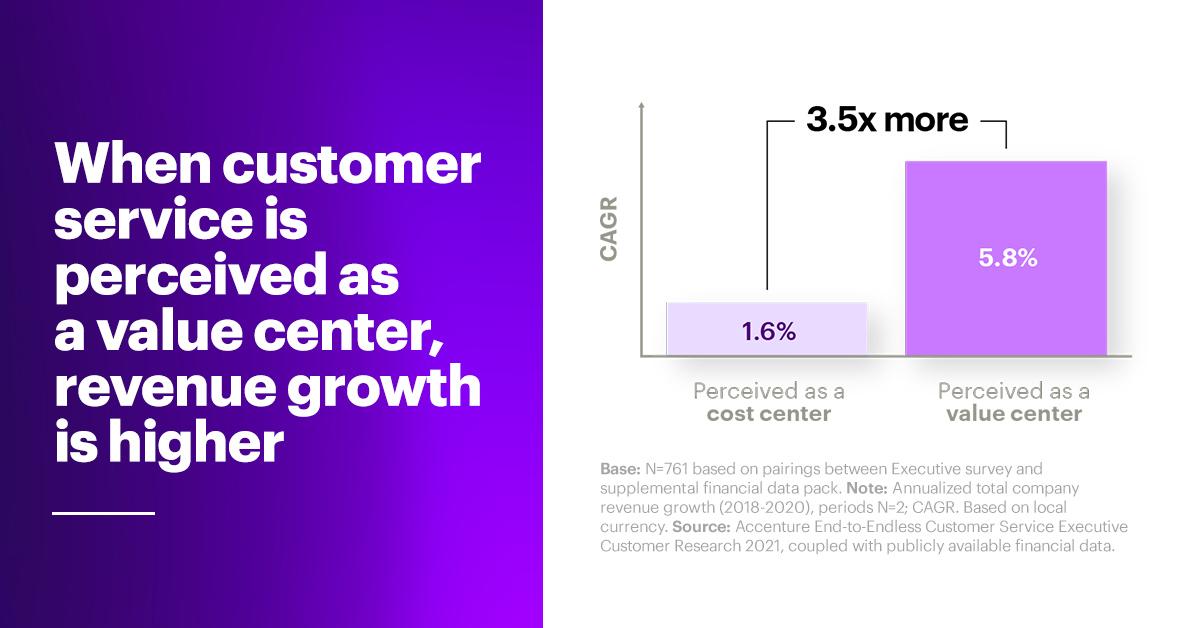What constitutes great customer service? For decades, satisfaction and efficiency have been the holy grail, and customer service executives and their teams have strived to deliver responsive, reliable service at the lowest cost possible.
But what if service had more potential, beyond speed and efficiency? What if instead of being solely reactive, customer service could be more proactive, becoming an engine of growth for your business?
New research from Accenture suggests that one in five companies have already evolved their thinking about the role of customer service. They view customer service as a value center, an engine for improving customer relationships and driving sustainable growth. That shift is paying off. In fact, these companies are achieving 3.5 times more revenue growth than those managing service as a cost center. And they're realizing that growth while spending only about half a percent more of their revenue on customer service.

How can you emulate their approach and their success? Accenture's research and advanced modeling uncovered the three opportunities to use service as a growth engine:
1.Grow trust with proactive, predictive service.
The survey found that one-third of customers still view service as a utility, something they need but don't think much about unless they have an issue. An even greater proportion of customers indicated that they value more proactive service but aren't yet receiving that kind of support (78 percent of B2B customers and 66 percent of B2C customers).
To deliver, proactive service requires capturing customer data, strategically identifying triggers across the customer lifecycle, and enabling with technology to deliver proactive experiences. With these capabilities, it becomes possible to anticipate and identify when you're at risk of not meeting customers' expectations, promised product or service performance, and capitalize on customer growth opportunities.
For example, filing for unemployment benefits can be fraught with emotion and complexity. A state unemployment agency launched a solution focused on personalized engagement and more intuitive service using data-driven triggers and an artificial intelligence-powered engine to gain contextual awareness. The agency crafted proactive citizen conversations to address anticipated needs, making it possible to engage thousands of people via automated SMS text messages with live agent escalation.
Key takeaway: Mitigate the severity and frequency of customer issues by injecting proactive, predictive capabilities throughout your customer experience.
2. Grow usage by helping customers get more value.
Customers have a strong desire for service interactions with trusted advisors. Rather than focusing solely on issue resolution, an advisor is committed to maximizing the value customers realize and helping them achieve targeted outcomes.
In the B2B world, a trusted advisor approach is nothing new. Assigning a dedicated sales rep, account rep, or customer success manager is standard practice when serving business customers. In fact, we found that 95 percent of B2B customers have some kind of dedicated support working on their behalf. In B2C, only 46 percent reported access to that kind of support, but more than half (54 percent) would like that option.
For example, a commercial bank in Asia developed and delivered an award-winning digital transformation strategy that combines advanced data and analytics capabilities with people-focused processes and tools. Together, these capabilities enable highly personalized sales and service experiences that demonstrate the bank's commitment to customer success.
Key takeaway: Help customers maximize the value from their purchases by offering them strategic advice that's personalized and contextually relevant.
3. Grow possibility by activating service insights in the front office.
No function is closer to your customers than service. Every day these channels collect feedback and input from customers. How are you capturing, analyzing, distributing, and leveraging this information? How are you using it to inform product development?
Our research suggests that the service function should be highly influential as you're creating and improving products. Even so, only about 60 percent of businesses surveyed say that they often or always involve service in product development. These same companies also experience higher revenue growth. Indeed, those that report always involving their service organizations in new product development are achieving up to 10 times more revenue growth than companies that keep these functions separate.
An online property exchange network in Australia ensured they were being customer-centric when they created an app to provide an efficient and safe property settlement experience for both buyers and sellers. For the new app, the company heavily leveraged customer feedback to ensure the product met user's needs, driving more than 75,000 home buyers to use the app in its short history.
Key takeaway: Make insights from the service organization integral to your product innovation process.
Focusing only on the speed, efficiency, and cost of reactive customer service is a race to the bottom. It also puts revenue at risk. It's time to start nurturing a different mindset about how you deliver value to customers. Assess how your current capabilities support proactive, predictive support; greater focus on customer success; and service-informed product development. Then build your plan for transforming service into a driver of value for your customers and your business.
Erika Simpson is a managing director in Accenture Strategy, leading customer sales and service.